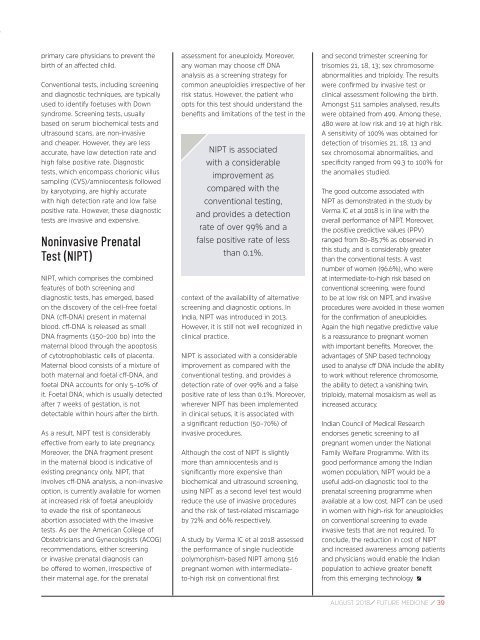FM AUGUST 2018 ISSUE1 - digital edition
You also want an ePaper? Increase the reach of your titles
YUMPU automatically turns print PDFs into web optimized ePapers that Google loves.
primary care physicians to prevent the<br />
birth of an affected child.<br />
Conventional tests, including screening<br />
and diagnostic techniques, are typically<br />
used to identify foetuses with Down<br />
syndrome. Screening tests, usually<br />
based on serum biochemical tests and<br />
ultrasound scans, are non-invasive<br />
and cheaper. However, they are less<br />
accurate, have low detection rate and<br />
high false positive rate. Diagnostic<br />
tests, which encompass chorionic villus<br />
sampling (CVS)/amniocentesis followed<br />
by karyotyping, are highly accurate<br />
with high detection rate and low false<br />
positive rate. However, these diagnostic<br />
tests are invasive and expensive.<br />
Noninvasive Prenatal<br />
Test (NIPT)<br />
NIPT, which comprises the combined<br />
features of both screening and<br />
diagnostic tests, has emerged, based<br />
on the discovery of the cell-free foetal<br />
DNA (cff-DNA) present in maternal<br />
blood. cff-DNA is released as small<br />
DNA fragments (150–200 bp) into the<br />
maternal blood through the apoptosis<br />
of cytotrophoblastic cells of placenta.<br />
Maternal blood consists of a mixture of<br />
both maternal and foetal cff-DNA, and<br />
foetal DNA accounts for only 5–10% of<br />
it. Foetal DNA, which is usually detected<br />
after 7 weeks of gestation, is not<br />
detectable within hours after the birth.<br />
As a result, NIPT test is considerably<br />
effective from early to late pregnancy.<br />
Moreover, the DNA fragment present<br />
in the maternal blood is indicative of<br />
existing pregnancy only. NIPT, that<br />
involves cff-DNA analysis, a non-invasive<br />
option, is currently available for women<br />
at increased risk of foetal aneuploidy<br />
to evade the risk of spontaneous<br />
abortion associated with the invasive<br />
tests. As per the American College of<br />
Obstetricians and Gynecologists (ACOG)<br />
recommendations, either screening<br />
or invasive prenatal diagnosis can<br />
be offered to women, irrespective of<br />
their maternal age, for the prenatal<br />
assessment for aneuploidy. Moreover,<br />
any woman may choose cff DNA<br />
analysis as a screening strategy for<br />
common aneuploidies irrespective of her<br />
risk status. However, the patient who<br />
opts for this test should understand the<br />
benefits and limitations of the test in the<br />
NIPT is associated<br />
with a considerable<br />
improvement as<br />
compared with the<br />
conventional testing,<br />
and provides a detection<br />
rate of over 99% and a<br />
false positive rate of less<br />
than 0.1%.<br />
context of the availability of alternative<br />
screening and diagnostic options. In<br />
India, NIPT was introduced in 2013.<br />
However, it is still not well recognized in<br />
clinical practice.<br />
NIPT is associated with a considerable<br />
improvement as compared with the<br />
conventional testing, and provides a<br />
detection rate of over 99% and a false<br />
positive rate of less than 0.1%. Moreover,<br />
wherever NIPT has been implemented<br />
in clinical setups, it is associated with<br />
a significant reduction (50–70%) of<br />
invasive procedures.<br />
Although the cost of NIPT is slightly<br />
more than amniocentesis and is<br />
significantly more expensive than<br />
biochemical and ultrasound screening,<br />
using NIPT as a second level test would<br />
reduce the use of invasive procedures<br />
and the risk of test-related miscarriage<br />
by 72% and 66% respectively.<br />
A study by Verma IC et al <strong>2018</strong> assessed<br />
the performance of single nucleotide<br />
polymorphism-based NIPT among 516<br />
pregnant women with intermediateto-high<br />
risk on conventional first<br />
and second trimester screening for<br />
trisomies 21, 18, 13; sex chromosome<br />
abnormalities and triploidy. The results<br />
were confirmed by invasive test or<br />
clinical assessment following the birth.<br />
Amongst 511 samples analysed, results<br />
were obtained from 499. Among these,<br />
480 were at low risk and 19 at high risk.<br />
A sensitivity of 100% was obtained for<br />
detection of trisomies 21, 18, 13 and<br />
sex chromosomal abnormalities, and<br />
specificity ranged from 99.3 to 100% for<br />
the anomalies studied.<br />
The good outcome associated with<br />
NIPT as demonstrated in the study by<br />
Verma IC et al <strong>2018</strong> is in line with the<br />
overall performance of NIPT. Moreover,<br />
the positive predictive values (PPV)<br />
ranged from 80–85.7% as observed in<br />
this study, and is considerably greater<br />
than the conventional tests. A vast<br />
number of women (96.6%), who were<br />
at intermediate-to-high risk based on<br />
conventional screening, were found<br />
to be at low risk on NIPT, and invasive<br />
procedures were avoided in these women<br />
for the confirmation of aneuploidies.<br />
Again the high negative predictive value<br />
is a reassurance to pregnant women<br />
with important benefits. Moreover, the<br />
advantages of SNP based technology<br />
used to analyse cff DNA include the ability<br />
to work without reference chromosome,<br />
the ability to detect a vanishing twin,<br />
triploidy, maternal mosaicism as well as<br />
increased accuracy.<br />
Indian Council of Medical Research<br />
endorses genetic screening to all<br />
pregnant women under the National<br />
Family Welfare Programme. With its<br />
good performance among the Indian<br />
women population, NIPT would be a<br />
useful add-on diagnostic tool to the<br />
prenatal screening programme when<br />
available at a low cost. NIPT can be used<br />
in women with high-risk for aneuploidies<br />
on conventional screening to evade<br />
invasive tests that are not required. To<br />
conclude, the reduction in cost of NIPT<br />
and increased awareness among patients<br />
and physicians would enable the Indian<br />
population to achieve greater benefit<br />
from this emerging technology<br />
<strong>AUGUST</strong> <strong>2018</strong>/ FUTURE MEDICINE / 39


















